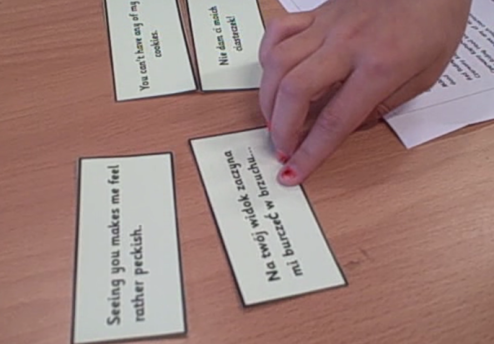The EAL Journal blog publishes plain language summaries of EAL-related Master’s and Doctoral research. In this post Dominika Gordon, EAL teacher at Eaton Square School in Kensington, London presents a summary of her Master’s research on using bilingual books as a way to foster biliteracy among bilingual pupils.
If you would like to write a plain language summary of your postgraduate research we want to hear from you. Check out the instructions to authors here.

Dominika Gordon
Background – Why did I do this research?
Bilingual learners have always been part of the British education system. Although much research has demonstrated the benefits of bilingualism, it seems that schools often fail to acknowledge the potential of their bilingual students. It is still common, for example, to hear teachers repeating the myth that learning another language will confuse children and slow the process of learning English, rather than hear them talk in terms of the assets that bilingualism can bring.
For my Master’s research I was interested in how to encourage bilingual learners to use and have pride in their first languages (L1s). In particular I was interested in fostering biliteracy. That is, literacy in both English and their L1. To do this I explored the potential for using dual language books in class. As literacy in L1 can be less well developed than literacy in English, I wanted to explore how bilingual books could foster transfer of skills from English to the L1, and whether these books empower children to become confident bilingual readers.
What did I do?
Using a bilingual version of a story called ‘Not Again, Little Red Riding Hood’, participants took part in a series of lessons that explored the use of the two languages in the book.

As well as read aloud sessions, the children created language portfolios. These included creating a Venn diagram and sound chart to explore similarities and differences between the grapheme/phoneme relationships in both languages, translating activities, such as matching two set of cards with sentences taken from the book, and comparisons of vocabulary to facilitate discussions about meaning in both languages. In addition, they identified and compared reading strategies that they could use in English and Polish. The reading sessions were audio recorded and observed by the teacher.
Following the reading sessions, the transcript of the recorded interactions between participant and teacher were coded to explore the whether using the dual language books contributed to the development of the children’s biliteracy.
What did I find?
Pupils associated their two languages with different contexts: Polish and Polish Romani for home, and English for school. Since school was the place where they mainly used English, at first it seemed difficult for them to talk about their learning experiences and specific skills in Polish. However, the children came to welcome using their L1 for reading. For them, the languages ended up complementing each other. Polish was a solution to problems associated with comprehension in English. They quickly realised that developing their Polish literacy could help form a bridge between their two linguistic worlds.
Polish became a stimulus to talk about other stories the pupils knew in their L1. They were able to use their cultural knowledge of traditional tales to support their general literacy development. If restricted to only English, this may not have been possible. They engaged in detailed discussions about the story, switching between languages as necessary. I believe that this enabled them to understand the content of the story in more depth, and experience greater ownership of their knowledge acquired through their L1. This was visible when they started using Polish to retell the story or include additional information which they could not do in English.
I found that dual language book extended children’s knowledge of phoneme-grapheme correspondence in English, Polish and across both languages. To assess their skills, I asked them to read the sounds in both languages using the phonics assessment sheets. Through using the sound charts and Venn diagram, I found out that they could apply their knowledge gained through synthetic phonics in English to compare it with the Polish alphabet. For example, they identified examples such as /j/ which in English is represented by the grapheme <y>, and in Polish by <j>. They agreed that maybe some sounds existed only in one alphabet.
When children were translating sentences and talking about the meaning of particular words and expressions, they noticed that the same concepts can be denoted differently in both languages and they became weary of the synonymous expressions. One of the sentences taken from the book was “I’m starving” which was translated as “Umieram z głodu” – literally “I am dying of hunger”. The children noticed that the literal translation is imperfect and that the two languages require different expressions to convey the same meaning. They were also able to extend their English vocabulary by comparing new English words with their Polish versions in the text.

Finally, through dual language books children were able to transfer the strategies they knew in English for their reading in Polish. They identified and named strategies that were helpful for their reading in English and demonstrated evidence of using these strategies and methods in both languages.

What it means?
The study’s aim was to explore the use of dual language books as a tool for learning. I concluded that dual language books helped children to access the English text and encouraged them to value their L1. Most importantly, the dual language books developed children’s identities as bilinguals and made them aware that their languages are of equal value and importance when it comes to learning.
In order to achieve positive outcomes, however, teachers must be provided with effective methods and strategies, as well as with additional training so both teacher and student benefit from the full potential of emergent bilinguals’ existing skills.
This post is a plain language summary of Dominika’s Master’s dissertation, The Role of Dual Language Books in Fostering Bilingualism, completed at Goldsmiths, University of London. The full dissertation can be obtained at Goldsmiths’ Library.

EALJournal.org is a publication of NALDIC, the subject association for EAL. Visit www.naldic.org.uk to become a member.



Thank you for sharing this. It was a really useful, interesting read.
LikeLike
Thank you, Emma! I’m glad you found it useful!
LikeLike
Very reassuring summary of your dissertation. It was really interesting and the point I take with me from your summary is how Dual Language books build confidence and experimentation with language.
(Incidentally, my son, Dr Sahil Dutta, has just moved from Warwich to Goldsmith. He teaches Political Economy.)
At Mantra Lingua we have so many topics for research on L1 and I know that this is the time of year where Masters students are looking for topics.
So here is another call to English and EAL Lecturers to please please contact me to for a list of ideas to research on L1!
LikeLike
Hello Dominika,
Only if is not a problem, would you be able to send me an electronic version of the Literature Review on Dual Language books which was part of your dissertation? I am not sure if there are many published work in UK on the effectiveness of having L1 in picture books and your review may help shed some light.
Thanks, and look forward to your reply
Robene
LikeLike
Thank you! The children felt very empowered and they enjoyed it a lot. Let me know how can I get in touch to send it over.
LikeLike
[…] Read more HERE. […]
LikeLike
Wonderful to know of the work you have done. In 1983 I starting learning Polish on a Saturday. This was held in Glasgow in Sikorski society. I have continued my interest and work in this field.I was and still am a teacher (retired) but found my experiences of learning Polish helped enormously in my primary teaching and EAL teaching. Many thanks, Stella Neil.
LikeLike